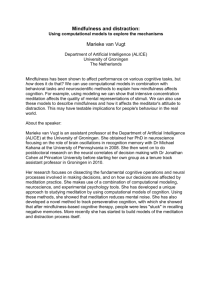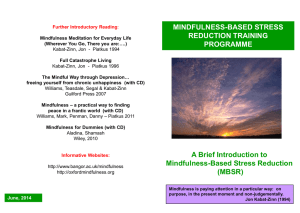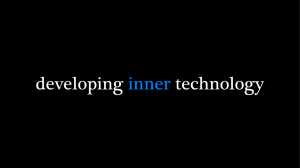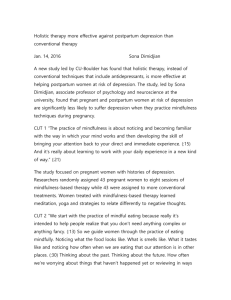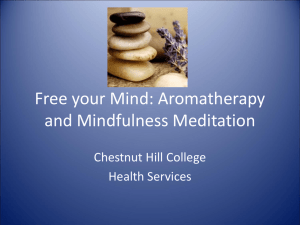Transcript of the talk
advertisement
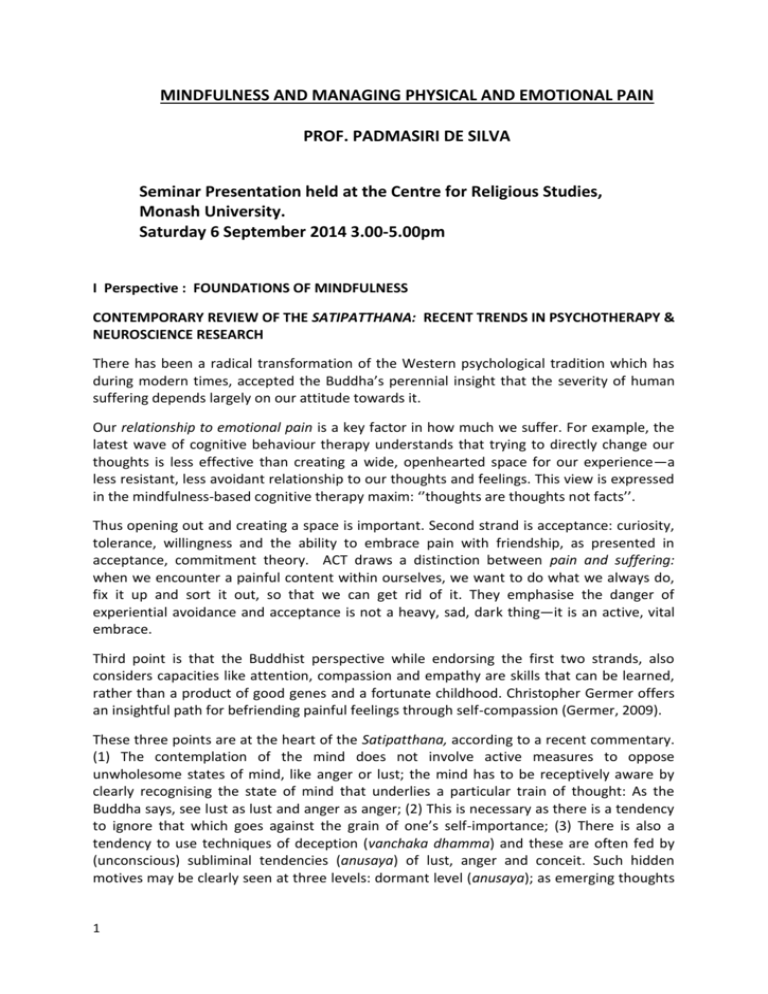
MINDFULNESS AND MANAGING PHYSICAL AND EMOTIONAL PAIN PROF. PADMASIRI DE SILVA Seminar Presentation held at the Centre for Religious Studies, Monash University. Saturday 6 September 2014 3.00-5.00pm I Perspective : FOUNDATIONS OF MINDFULNESS CONTEMPORARY REVIEW OF THE SATIPATTHANA: RECENT TRENDS IN PSYCHOTHERAPY & NEUROSCIENCE RESEARCH There has been a radical transformation of the Western psychological tradition which has during modern times, accepted the Buddha’s perennial insight that the severity of human suffering depends largely on our attitude towards it. Our relationship to emotional pain is a key factor in how much we suffer. For example, the latest wave of cognitive behaviour therapy understands that trying to directly change our thoughts is less effective than creating a wide, openhearted space for our experience—a less resistant, less avoidant relationship to our thoughts and feelings. This view is expressed in the mindfulness-based cognitive therapy maxim: ‘’thoughts are thoughts not facts’’. Thus opening out and creating a space is important. Second strand is acceptance: curiosity, tolerance, willingness and the ability to embrace pain with friendship, as presented in acceptance, commitment theory. ACT draws a distinction between pain and suffering: when we encounter a painful content within ourselves, we want to do what we always do, fix it up and sort it out, so that we can get rid of it. They emphasise the danger of experiential avoidance and acceptance is not a heavy, sad, dark thing—it is an active, vital embrace. Third point is that the Buddhist perspective while endorsing the first two strands, also considers capacities like attention, compassion and empathy are skills that can be learned, rather than a product of good genes and a fortunate childhood. Christopher Germer offers an insightful path for befriending painful feelings through self-compassion (Germer, 2009). These three points are at the heart of the Satipatthana, according to a recent commentary. (1) The contemplation of the mind does not involve active measures to oppose unwholesome states of mind, like anger or lust; the mind has to be receptively aware by clearly recognising the state of mind that underlies a particular train of thought: As the Buddha says, see lust as lust and anger as anger; (2) This is necessary as there is a tendency to ignore that which goes against the grain of one’s self-importance; (3) There is also a tendency to use techniques of deception (vanchaka dhamma) and these are often fed by (unconscious) subliminal tendencies (anusaya) of lust, anger and conceit. Such hidden motives may be clearly seen at three levels: dormant level (anusaya); as emerging thoughts 1 (pariyutthana) or result in ungovernable impulsive actions (vitikamma) or physiological pressure. A fourth point. If we look at anger/aversion of our pain, as a purely negative emotion to be destroyed, we lose sight of the fact that for Buddhism such an emotion has a hermeneutical role, where the cognitive meaning is important, the message in the emotion, and with a little magic we see it’s impermanent nature. The Buddha has said, “see aversion as aversion”, “lust as lust”, do not judge them as good and bad, see them as impersonal processes (as dharmas). This attitude keeps off resentment, guilt and in neurological terms, REACTIVITY. RESILLIENCE is the most important emotional style/ skill to be developed. Thus both Buddhist contemplative practice and Western psychotherapy are twin paths to emotional healing. It may be said from my personal experience as a therapist that therapy is a useful adjunct to meditative practice. A fifth point: Ven. Nyanaponika says, do not throw away your negative emotions as they can be transformed and by a little magic converted into their opposites (patience and forgiveness towards yourself/others) or made objects of meditation (dhammanupassana) (liberation by insight); method of remedying one emotion by another (is advocated by the philosopher Spinoza), changing aversion by compassion and kindness towards one self. Philosopher Nietzsche and the Tibetan Buddhist tradition recognise that there is vital power in some negative emotions that can be harnessed—they can endanger illness or show a path to cure. (see, de Silva, 2014, pp163—166), on Mindfulness-Based Ëmotion-Focussed Therapy (EFT). Tibetan Buddhism advocates “metabolizing anger” with the image of the peacock that eats poison, but generates the splendour of the multi-coloured feathers. 2. THE STORY: THREE ICONS OF PAIN MANAGEMENT: Jon Kabat-Zinn, Vidyamala Burch— Breathworks Program; Risa Kaparo-Awakening Somatic Intelligence. Vidyamala was trained in the mindfulness-based Stress Reduction Therapy by Jon-Kabat-Zinn and MBCT (Mindfulness-Based Cognitive Therapy (Williams & Kabat-Zinn), and I shall explain the nature of this therapy. In fact the earliest mindfulness-based therapy, Behaviour Modification Therapy, was initiated by a close Sri Lankan friend, the late Padmal de Silva). The Structure of Satipatthana and Mindfulness-Based Cognitive Therapy: To bring awareness to body (kaya), feelings (vedana) and thoughts (citta) are three facets covered in MBCT. The fourth item in the satipatthana, dhamma is hard to translate, and at least one meaning is the laws that govern the mind-body linkage, and we will not examine this dimension just now. The body scan practiced in MBCT involves: direct experience of physical sensations, being with the body in the present moment; be intentional about where and how the attention is placed, deliberately engage and disengage as we move through the body; relate skilfully to mind wandering, without judging them; allowing things to be as they are, relaxation instead of restlessness. Feelings: though the range of emotions we experience is vast, like in Buddhism, MBCT recognises at the experiential gut level, that we constantly register our internal and external experience as pleasant, unpleasant and neutral. Aversive reactions are triggered by unpleasant feelings, and its impact on the body is seen. Tuning in and befriending feelings helps to see linkages between body and feelings. In Buddhist practice, by using the technique of bare attention, any transition from painful 2 feelings to negative emotions triggered by subliminal anger (patighanusaya) or a transition of pleasant feelings to lust/greed, triggered by subliminal lust (raganusaya) are watched with vigilance. It has been observed that in MBCT, the difference between knowing that our experience is made up of body sensations, thoughts and feelings and actually directly experiencing this interplay is huge. The focus on the automatic patterns of aversion and clinging play a crucial role in the eight- week MBCT program. Auto-pilot of thinking. Our skills with practical activities have become our automatic repertoire, and this way of habitual problem solving has become automatised. Often beyond our conscious awareness, the normal thinking mind is engaged in automatic activity of judging and monitoring, but this habitual turn of mind that takes place automatically makes the person incapable of making conscious choices in responding to experience, and this narrowed activity may have a catastrophic impact on our emotional lives as thought and emotions have an integral relations, as unlike feelings emotions are nourished by our thought patterns. This pattern described as the “Doing Mode”, rather than the Being-mode which is mindful of what is happening, leads to repetitive automatic thoughts: “though I thought that this time I will get the job, I am a failure, I just cannot see any alternative, I have no one to help me...” and so the auto-pilot works, instead of searching for positives and this sort of perspectives are at the center of depression and anxiety. Rumination is an attempt to solve an emotional problem in the most destructive way, as our emotional life is not a problem and the extra dose of suffering is our own creation. For instance, in itself sadness is not a problem as it is an innate part of being human, and we cannot try to fix it, and thus a passing state of sadness may lead to persistent unhappiness, as I have described in an article on the “Lost Art of Sadness”de sIlva, 2014, pp 164-69). Experiential avoidance to which I have referred earlier makes the condition still worse, as reservoirs of unprocessed material accumulate. When we get to understand negative emotions, the difference between emotional reactivity as different from responding would become clear. II. PAIN MANAGEMENT Vidyamala Burch suffered from chronic back pain for over thirty years due to congenital weakness, a car accident and multiple surgeries. She was first trained by Kabat-Zinn following his program (outlined above) and then has over the years helped thousands of sufferers to live more fulfilling lives, using the Breathworks, 8 steps program. Risa Kaparo worked on Äwakening Somatic Intelligence—the art and practice of embodied mindfulness. Risa Kaparo’s story is remarkable: “Somatic learning is not something I learnt from books or teachers but from my own Body”. She was originally an artist who was given an assignment by the government to build a fibre art playground ground on rock, but imagined that the rock ground was soft and possible to handle with a jack hammer; the rock proved to be hard and while trying to use it, the hammer hit back her body with severe injuries, and the injury was so severe, and the suffering she underwent is hard to narrate, unless you read her story. After gradual recovery, she came under the influence of Brother David, who was both a Benedictine monk and a Buddhist monk at the same time and was more intimately open to the influence of Jiddu Krishnamurti and remarkable group of seers—the perennial spring of mysticism. While teaching sculpture to a group of blind students who had a remarkable sense of the vibrations of their body, Risa made it a paradigm experience to access what she 3 called the wisdom of her own body. Her personality-- artist, poet, therapist, mystic nourished this remarkable story of the pioneer of somatic intelligence. III THEORY OF PAIN MANAGEMENT Traditional Sensory neurophysiology that dominated pain research was influenced by a Cartesian Dualism: the brain detects and perceives pathological bodily processes passively and mechanically—they looked at the body and mind as separate entities. According to the new view, pain is subjective and physical pain is invariably tied to our emotions: “Pain refers broadly to describe any unpleasant experience that has a physical dimension, whether caused by disease injury, stress or emotion” (Burch, 2008). PURE PAIN IS NEVER DIRECTED AS AN ISOLATED SENSATION.PAIN IS ALWAYS ACCOMPANIED BY EMOTION AND MEANING UNIQUE TO EACH INDIVIDUAL. There is a difference between primary pain and secondary pain. Secondary pain is beyond mere physical sensations, adding both physical and emotional responses. Craig Hassad points out that mental and emotional responses, the second layer to physical pain may be described as STRESS. (1) Stress increases the output of inflammatory chemicals, we have poured fuel on the inflammatory fire; (2) Secondly, we may be physically tensed when stressed, which may add to the muscle spasms that is present at the site of the pain; (3) When we become hyper-vigilant for the pain (always looking out for it), we sensitise the pain circuits of the brain. This may be an important reason, why mindfulness is so therapeutic for preoccupation about the pain and reduces the emotional reactivity of chronic pain, as it helps to unhook attention from the preoccupation about the pain and reduces the emotional reactivity to it when noticed.(4) Stress seems to change the chemical composition of the nerve endings, making them more liable to fire off pain messages. It is just the unconscious way we anticipate, react and respond to pain, and mindfulness can reverse the situation (Hassad, Mindfulness for Life, 2012,p 132). Chronic pain syndromes are common in the presence of stress. Buddhism & Mindfulness: Adding Emotional Responses to Physical Pain The Buddha is in fact saying, Rather than being driven solely by the desire to eliminate suffering, the wise person learns to change the relationship to suffering. The Celebrated Sallaka Sutta, Story of the two arrows/darts (Samyutta Nikaya/Kindred Sayings, Vedana samyutta, 36.6) is a beautiful paradigm illustration. “When an ordinary person experiences a painful bodily feeling they worry, agonise and feel distraught. Then they feel two types of pain, one physical and one mental. It’s as if this person was pierced by an arrow, and then immediately afterwards by a second arrow, and they experience the pain of two arrows.” Having being touched by painful feeling, they resist and resent it—sorrows, grieves, laments, beating his breast, becomes distraught—the subliminal anger (patigha anusaya) dominate, and he knows no other alternative except sensual pleasure and such diversions, subliminal tendency to obtain pleasures (raga anusaya) captures his mind; compulsive distractions like alcohol and cigarettes overtakes his mind. Vidyamala Burch also citing this sutta says, people do resort to blocking out the pain, by recreational drugs, shopping, chocolate, work, talking, sleeping and so on. They can also get drowned and overwhelmed, depressed. 4 My Personal Story In the context of these three great icons of pain management, I am not giving a narrative of my experience of two months of severe physical pain and the fourfold facets of the therapy which brought me back to normal life, which will be presented at a forthcoming conference, ITMBU conference on Pain Management. The most important component was the practice of Vipassana meditation with a focus on the vibration patterns in the body, briefly summarised below. (Also see, de Silva, 2013 in the footnotes) The sixth sense: The five senses bring information with the translation of neural impulses to smell, taste, sound, touch and visual image. While the five senses bring information from the outside world, a consciousness independent of the five senses emerge in deep meditative states, which is referred to as sixth sense (In Pali, anindriyapatibattha Vinnana— non-sensory consciousness). When the meditator shifts from samatha (Tranquility meditation) to insight meditation (vipassana), the ‘breath’ is seen as an air draft rather than as breath, and it is seen as a vibration pattern : the air (striker element), that which pushes; the point of touch, tip of the nose or lips, the base element (solidity); the rubbing of the air draft on the nose or lips, ignition (fire element)—the generation of heatness/coolness; the moist element—water. In deep meditation the whole process is seen as an impersonal process (devoid of a person). As the meditation develops (minimum 30 mts),the vibration patterns gradually display more refined qualities, as the gap between in-breath and outbreath becomes smaller, more refined qualities emerge: roughness and softness; flowing, hot-cold; contraction-expansion; and so on. Out of these qualities tightness and looseness, hot and dry, wet and moist are refined vibration patterns. The most important change, as the breath becomes finer and finer we experience what is called the “breath-Body”—the bodily dispositions (kaya-sankhara) and the feverish activity of the body subsides, (passambayam-kayasankhara). Body and mind emerge together and fades of together.. The tranquilization of the breath-body generates the contemplative emotions of joy (pity), rapture and well-being (sukha). The sixth sense is described by neurologist as, interoception. 5 REFERENCES Analayo, Satipatthana, The Direct Path to Realization, Windhorse Publications, Cambridge, 2010 (The best, Introduction to the Foundations of Mindfulness). Burch, Vidyamala, Living Well With Pain & Illness, 2008, Piatkus, London. de Silva, Padmasiri, 2014, An Introduction to Buddhist Psychology & Counselling, Palgrave-Macmillan, London, Chapter 5. de Silva, Padmasiri, “Ëmbodied Cognition and Emotions: A Buddhist Perspective On Body-Mind Reactivity in Daily Life and Contemplative Life”, Proceedings, Buddhism & Australia Conference, 2013, Perth (See, online), de Silva, Padmasiri, Contemplative Emotions, Monograph, in Preparation. Dhammajiva, Uda, Eriyagama, Mahathero, In this Life Itself, Practical Teachings on Insightful Meditation, NIssaranavanaya, Meethirigala. Germer, Christopher, 2009, The Mindful Path to Self- Compassion, Guilford Press, New York. Harris, Russel, For Embracing Your Demons, see, An Overview of Acceptance-Commitment Theory, Psychotherapy in Australia, 12, 2-8. Kabat-Zinn, Jon, Full Catastrphe Living, 1990, Delta Publishers, New York. Mark William et all,2012, Mindfulness-Based Cognitive Theory of Depression,2012, Guildford Press, New York. Kaparo, Risa, Awakening Somatic Intelligence: The Arts and Practice of Embodied Mindfulness, North Atlantic Books, 2012. Nyanaponika, Mahathero, 1986, The Power of Mindfulness, B.P.S., Kandy 6

